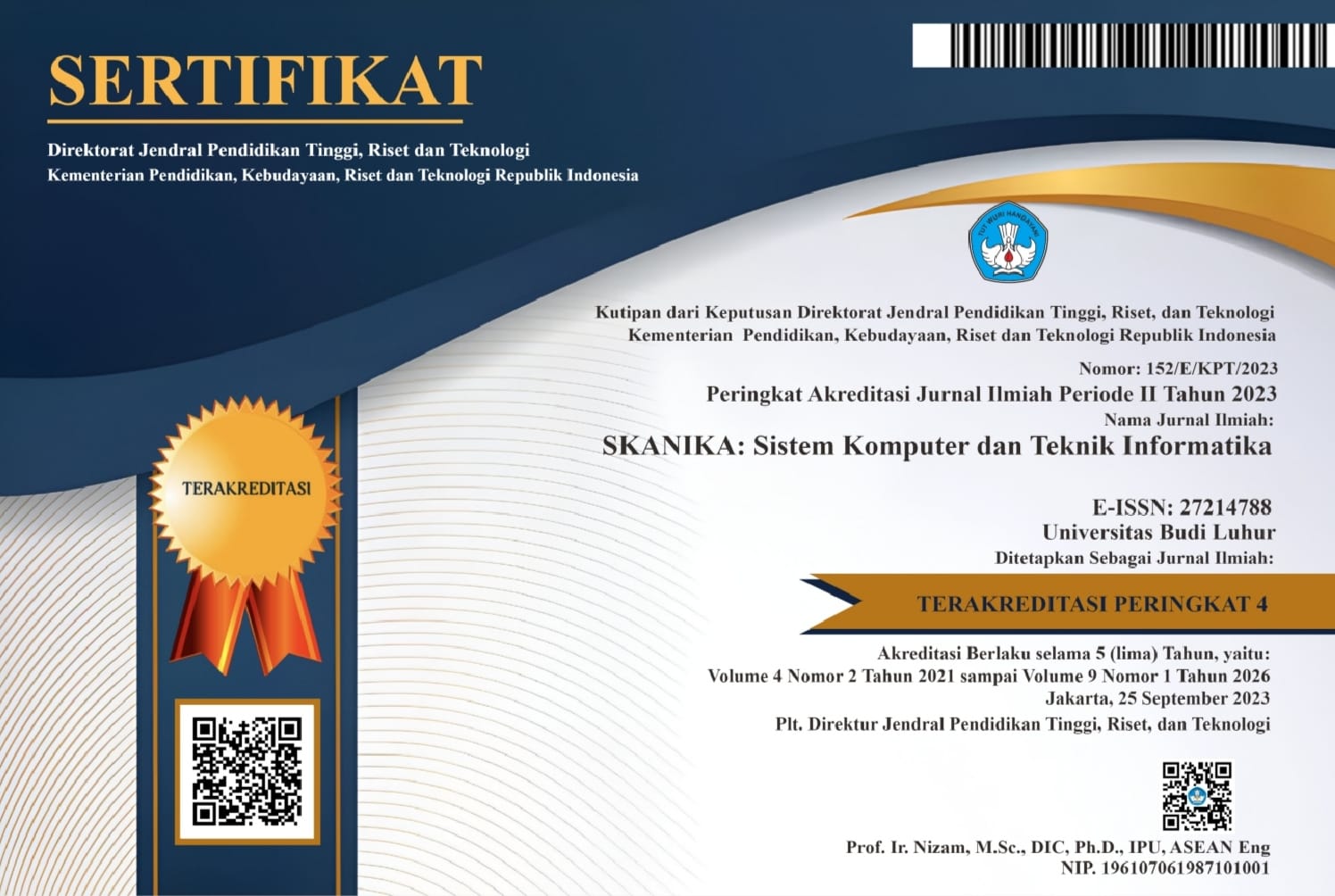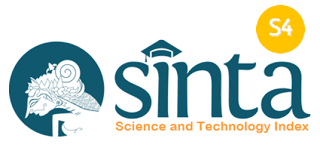PENERAPAN METODE GAMIFIKASI PADA APLIKASI GAME PENDIDIKAN PANCASILA BERBASIS MULTIMEDIA 2 DIMENSI
DOI:
https://doi.org/10.36080/skanika.v8i1.3319Keywords:
GAMIFICATION, PANCASILA EDUCATION, MDLC, UNITYAbstract
Improving the quality of human resources depends on education. However, the low quality of education in Indonesia is often caused by factors such as lack of facilities and infrastructure, high education costs, and unequal educational opportunities. At MI Al-Ihsan, the low learning outcomes of students in Pancasila Education are largely due to the large amount of material and theory that requires students to memorize a lot, then the lack of creativity and innovation in the teaching methods applied by teachers, which tend to be monotonous and uninteresting for students because the facilities and infrastructure are still inadequate. To overcome this problem, technology can be utilized through the application of gamification in learning media. This game is designed to attract students' interest by matching images with time limits, lives, scores, and leaderboards as well as learning materials that are in accordance with the curriculum. The methodology used in developing this application is the Multimedia Development Life Cycle (MDLC) and the application of gamification. The test results using the SUS (System Usability Scale) method obtained a score of 84.7, which means getting an A or Excellent grade. The results of the study showed that learning using game media such as gamification can make learning more interesting and effective. Students become more motivated and interested in studying Pancasila education materials which ultimately improves their learning outcomes.
Downloads
References
[2] E. Elvira, “Faktor – Faktor Yang Menyebabkan Kualitas Pendidikan Rendah Dan Metode Untuk Memperbaikinya (Studi pada : Sekolah Dasar di Desa Tonggolobibi),” Iqra: Jurnal Ilmu Kependidikan dan Keislaman, vol. 16, no. 2, pp. 93–98, 2021.
[3] Z. Zaenuri, and Siti Fatonah, “Analisis Implementasi Peran Guru Dalam Penanaman Nilai Karakter Toleransi Pada Mata Pelajaran PKn Di MI Ma’arif Darussalam Plaosan Yogyakarta,” Jurnal Riset Madrasah Ibtidaiyah (JURMIA), vol. 2, no. 1, pp. 181–190, 2022.
[4] Sa’odah, S. A. Oktavia, D. Damayanti, A. Ridwanita, and B. Aulia, “Kreatifitas Guru Dalam Meningkatkan Motivasi Siswa dengan Metode Pembelajaran PKN,” Jurnal Edukasi dan Sains, vol. 2, no. 1, pp. 123–131, 2020.
[5] S. Sodikin, Y. Efendi, and Y. Yatimollah, “Implementation of the Multimedia Development Life Cycle in Making Educational Games About Indonesia,” CESS (Journal of Computer Engineering, System and Science), vol. 8, no. 2, pp. 595-606, 2023.
[6] R. Y. Tyaningsih, et al., “Penerapan Metode Gamifikasi dalam Meningkatkan Motivasi Belajar Mahasiswa pada Mata Kuliah Geometri Analitik Bidang Melalui Aplikasi Kahoot,” Griya Journal of Mathematics Education and Application, vol. 2, no. 2, pp. 317–326, 2022.
[7] K. S. Mustaghfaroh, F. N. Putra, and R. S. A. Ananingtyas, “Pengembangan Media Pembelajaran Interaktif untuk Materi dan Perubahan Alam menggunakan MDLC,” JACIS: Journal Automation Computer Information System, vol. 1, no. 2, pp. 100–109, 2021.
[8] V. Wijaya and Y. Christian, “Perancangan dan Implementasi Video 360 School Tour dengan Metode MDLC di SMA Kartini Batam,” National Conference for Community Service Project (NaCosPro), vol. 4, no 1, 2022, pp. 2714–8599.
[9] P. A. Nanda, “Visualisasi Teknik Gerakan Yoga Dengan Metode Pengembangan Multimedia Berbasis Mobile Luther-Sutopo,” JURIKOM (Jurnal Riset Komputer), vol. 7, no. 2, pp. 207-213, 2020.
[10] R. Pratama and A. W. Sudrajat, “Pengukuran Tingkat Kebergunaan Aplikasi PLN Mobile Dengan Menggunakan Skala Kegunaan Sistem dan Teori Jakob Nielsen,” Jurnal informasi dan Komputer, vol. 11, no. 1, pp. 73–80, 2023.
[11] E. Kurniawan, N. Nofriadi, and A. Nata, “Penerapan System Usability Scale (SUS) dalam Pengukuran Kebergunaan Website Program Studi Di STMIK Royal,” Journal of Science and Social Research, vol. 5, no. 1, pp. 43-49, 2022.
[12] T. Hidayat, and S. Suryayusra, “Analisis E-Learning Universitas Muhammadiyah Palembang Pada Mahasiswa Menggunakan Metode System Usability Scale,” Jurnal Pengembangan Sistem Informasi dan Informatika, vol. 3, no. 3, pp. 116-126, 2022.
[13] A. A. N. H. Susila, and D. M. S. Arsa, “Analisis System Usability (SUS) dan Perancangan Sistem Self Service Pemesanan Menu di Restoran Berbasis Web,” Majalah Ilmiah UNIKOM, vol. 21, no. 1, pp. 3-8, 2023.
[14] T. Arianti, A. Fa’izi, S. Adam, and Mira Wulandari, “Perancangan Sistem Informasi Perpustakaan dengan Diagram UML,” Jurnal Ilmiah Komputer, vol. 1, no. 1, pp. 19–25, 2022.
[15] B. Wildan, A. P. Sari, and R. Nasution, “Sistem Informasi Manajemen Surat Berbasis Web untuk PT Clipan Finance Indonesia, Tbk,” Hexagon Jurnal Teknik dan Sains, vol. 2, no. 1, pp. 85–90, 2021.
[16] M. P. A.S and S. Dewi, “Implementasi Sistem Informasi Enterprise Pendaftaran dan Registrasi Siswa di Sekolah Menengah Kejuruan Swasta Kabupaten Bandung,” Jurnal Accounting Information System (AIMS), vol. 4, no. 2, pp. 29–36, 2021.
[17] W. Andriati, “Sistem Informasi Pelaporan Realisasi E-Order Berbasis Web Pada Pemerintah Kota Jakarta Timur,” Jurnal PROSISKO, vol. 10, no. 1, pp. 24-31, 2023.
[18] S. Ardiansyah, A. Setiorini, L. H. Atrinawati, and T. P. Fiqar, “Studi Kasus Dinas Perhubungan Kota Balikpapan,” MATRIK : Jurnal Manajemen, Teknik Informatika dan Rekayasa Komputer, vol. 19, no. 1, pp. 70–79, 2019.
[19] A. F. Yogananti, B. C. Pratama, and A. Akrom, “Usability Game Lokapala Collaborative Theory and System Usability Scale (SUS),” Journal of Animation and Games Studies, vol. 8, no. 1, pp. 49–66, 2022.
[20] M. A. Maricar and D. Pramana, “Usability Testing SUS dan Metode Perbandingan Grafik,” Jurnal Eksplora Informatika, vol. 9, no. 2, pp. 124–129, 2020
Downloads
Published
How to Cite
Issue
Section
License
Copyright (c) 2025 Risanty Amelia Putri, Sawali Wahyu

This work is licensed under a Creative Commons Attribution-ShareAlike 4.0 International License.
CC BY-SA 4.0
Creative Commons Attribution-ShareAlike 4.0 International
This license requires that reusers give credit to the creator. It allows reusers to distribute, remix, adapt, and build upon the material in any medium or format, even for commercial purposes. If others remix, adapt, or build upon the material, they must license the modified material under identical terms.
BY: Credit must be given to you, the creator.
SA: Adaptations must be shared under the same terms.ng












